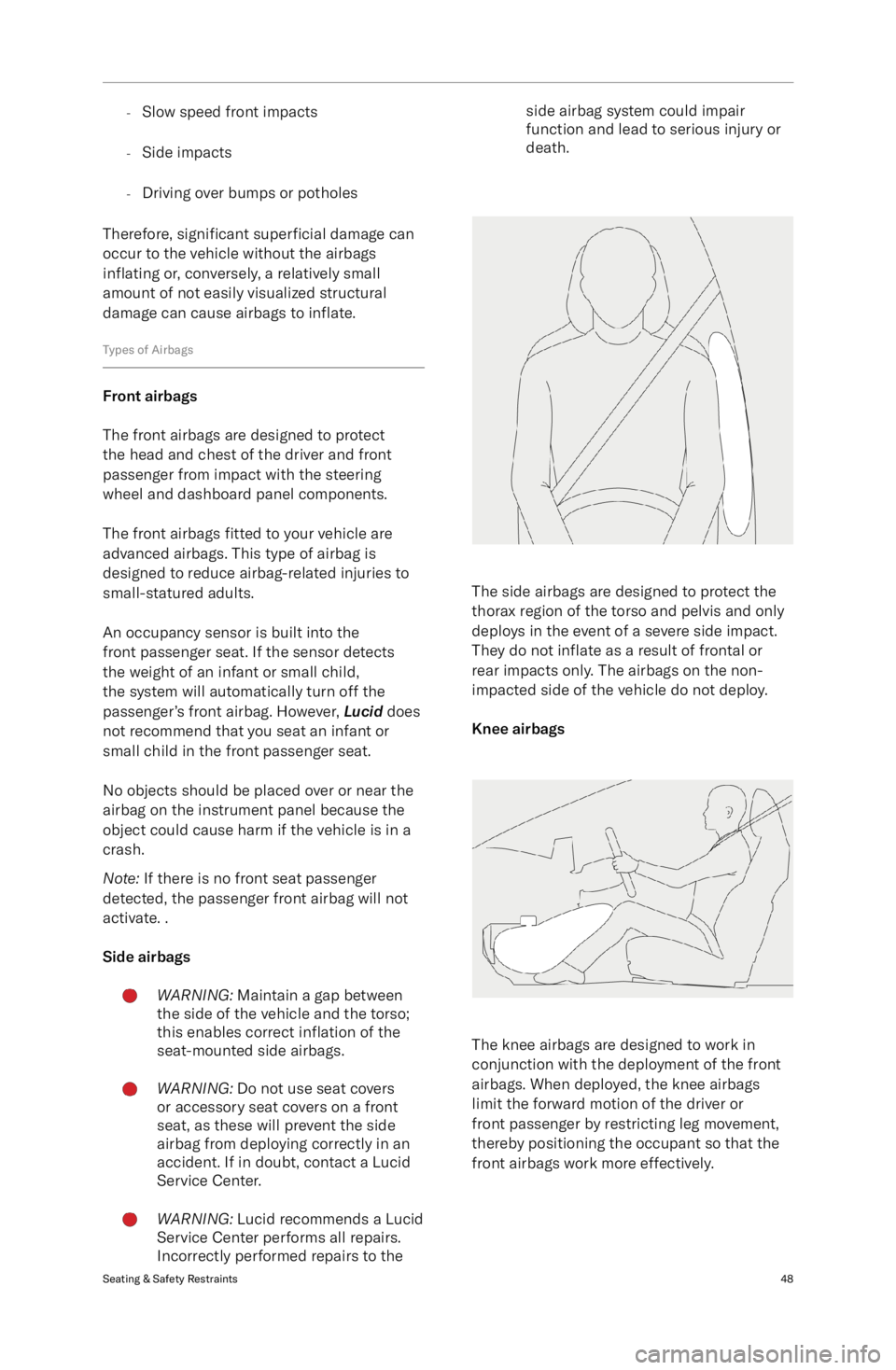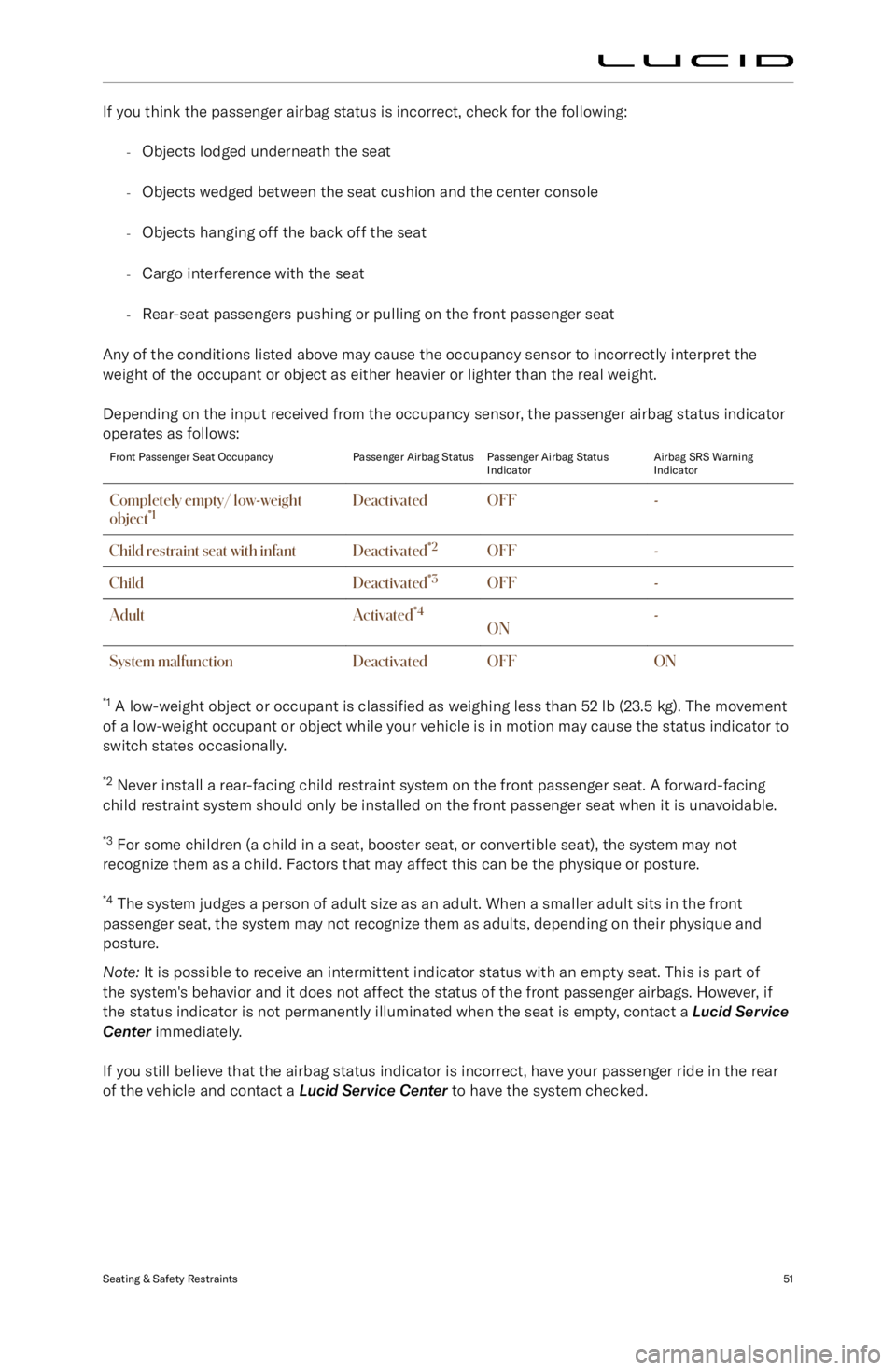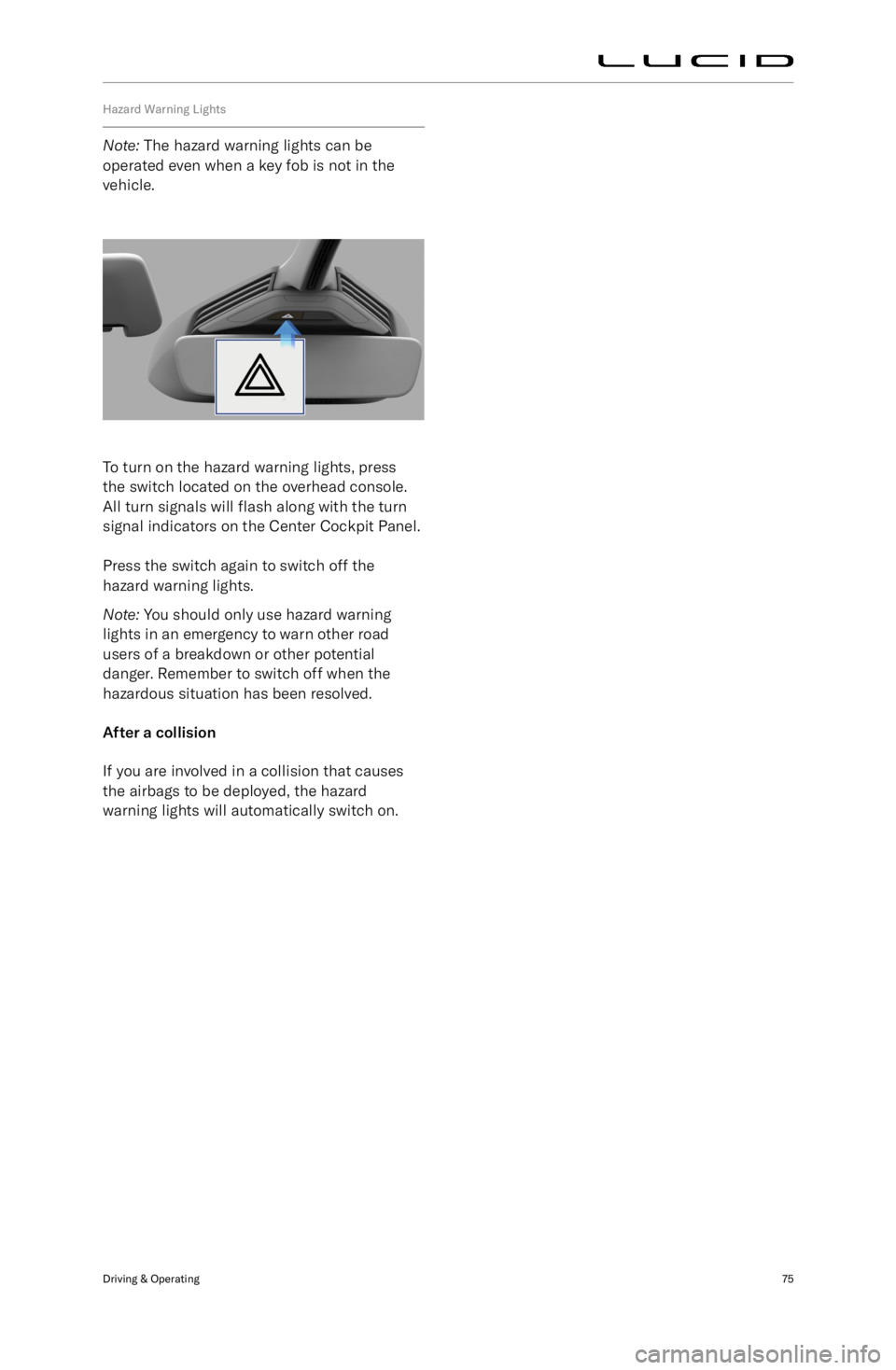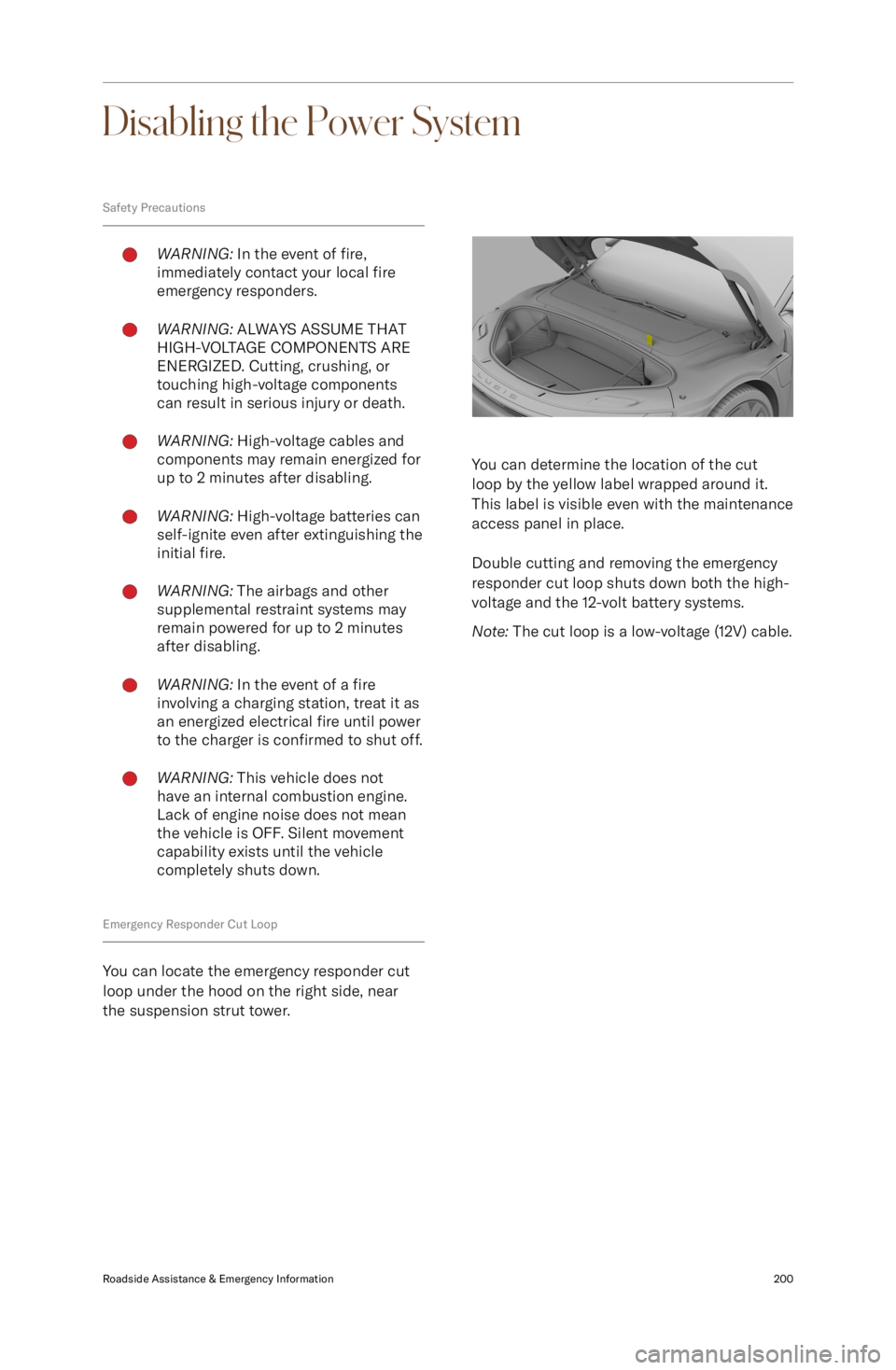airbag off LUCID AIR 2022 Owners Manual
[x] Cancel search | Manufacturer: LUCID, Model Year: 2022, Model line: AIR, Model: LUCID AIR 2022Pages: 241, PDF Size: 5.15 MB
Page 5 of 241

Using Seat Belts When Pregnant 39Seat Belt Pre-tensioners 39
Testing Seat Belts 40
Child Safety 41
Guidelines for Seating Children 41
Choosing a Child Safety Seat 41
Seating Larger Children 42
Installing Child Safety Seats 42
Installing LATCH or ISOFIX Child Seats 43 Installing Seat Belt Retained Child Seats 44
Attaching Upper Tether Straps 44
Child Safety Seat Warnings 45
Airbags 46 Location of Airbags and Airbag Sensors 46
Airbag Safety Information 47
Airbag Safety Labels 47
How the Airbags Work 47
Types of Airbags 48
Obstruction of Airbags 49
Front Passenger Seat Occupant Classification
System (OCS) 50
Effects of Airbag Inflation 53
Airbag SRS Warning Indicator 53
Airbag Service Information 53Driving & OperatingDriver Information 55
Vehicle Information and Alerts 55
Trip Information 55
Pilot Panel 56
Extending and Retracting the Pilot Panel 56
Center Cockpit Panel 57
Center Cockpit Panel - Overview 57
Warning Indicators 58
High-Voltage Drive System Failure 64
Charge and Power Meter 64
Battery State of Charge Indicator 64
Starting and Powering Off 65
Starting 65 Powering Off 65
Steering Wheel 66Adjusting the Steering Wheel Position 66
Steering Feel and Sensitivity 66
Steering Wheel - Right Controls 67
Steering Wheel - Left Controls 68
Page 61 of 241

-Slow speed front impacts
- Side impacts
- Driving over bumps or potholes
Therefore, significant superficial damage can
occur to the vehicle without the airbags
inflating or, conversely, a relatively small
amount of not easily visualized structural
damage can cause airbags to inflate.
Types of Airbags
Front airbags
The front airbags are designed to protect
the head and chest of the driver and front passenger from impact with the steering
wheel and dashboard panel components.
The front airbags fitted to your vehicle are
advanced airbags. This type of airbag is
designed to reduce airbag-related injuries to small-statured adults.
An occupancy sensor is built into the
front passenger seat. If the sensor detects
the weight of an infant or small child,
the system will automatically turn off the
passenger
Page 63 of 241

Front Passenger Seat Occupant Classification System (OCS)WARNING: Lucid strongly advises against seating a child on the front passenger seat, even
if the passenger airbag is Off. All occupants age 12 and under should ride in the rear seats.
See Child Safety Locks on page 21.WARNING: The full weight of the front seat passenger should always be directly on the
seat cushion. The passenger should never lift themselves off the seat cushion by using
the armrest in the door or the center console, by pressing their feet on the floor, by
sitting on the edge of the seat cushion, or by pressing against the backrest in a way that reduces pressure on the seat cushion. The passenger should never place anything (such
as a cushion) between themselves and the seat that could cause OCS to disable the front
passenger
Page 64 of 241

If you think the passenger airbag status is incorrect, check for the following:-Objects lodged underneath the seat
- Objects wedged between the seat cushion and the center console
- Objects hanging off the back off the seat
- Cargo interference with the seat
- Rear-seat passengers pushing or pulling on the front passenger seat
Any of the conditions listed above may cause the occupancy sensor to incorrectly interpret the
weight of the occupant or object as either heavier or lighter than the real weight.
Depending on the input received from the occupancy sensor, the passenger airbag status indicator
operates as follows:Front Passenger Seat OccupancyPassenger Airbag StatusPassenger Airbag Status
IndicatorAirbag SRS Warning
IndicatorCompletely empty/ low-weight
object *1DeactivatedOFF-Child restraint seat with infantDeactivated *2OFF-ChildDeactivated*3OFF-AdultActivated*4ON-System malfunctionDeactivatedOFFON
*1
A low-weight object or occupant is classified as weighing less than 52 lb (23.5 kg). The movement
of a low-weight occupant or object while your vehicle is in motion may cause the status indicator to
switch states occasionally.
*2 Never install a rear-facing child restraint system on the front passenger seat. A forward-facing
child restraint system should only be installed on the front passenger seat when it is unavoidable.
*3 For some children (a child in a seat, booster seat, or convertible seat), the system may not
recognize them as a child. Factors that may affect this can be the physique or posture.
*4 The system judges a person of adult size as an adult. When a smaller adult sits in the front
passenger seat, the system may not recognize them as adults, depending on their physique and
posture.
Note: It is possible to receive an intermittent indicator status with an empty seat. This is part of
the system
Page 88 of 241

Hazard Warning Lights
Note: The hazard warning lights can be
operated even when a key fob is not in the
vehicle.
To turn on the hazard warning lights, press the switch located on the overhead console.
All turn signals will flash along with the turn
signal indicators on the Center Cockpit Panel.
Press the switch again to switch off the
hazard warning lights.
Note: You should only use hazard warning
lights in an emergency to warn other road
users of a breakdown or other potential
danger. Remember to switch off when the
hazardous situation has been resolved.
After a collision
If you are involved in a collision that causes
the airbags to be deployed, the hazard
warning lights will automatically switch on.
Driving & Operating75
Page 213 of 241

Disabling the Power System
Safety PrecautionsWARNING: In the event of fire,
immediately contact your local fire
emergency responders.WARNING: ALWAYS ASSUME THAT
HIGH-VOLTAGE COMPONENTS ARE
ENERGIZED. Cutting, crushing, or
touching high-voltage components
can result in serious injury or death.WARNING: High-voltage cables and
components may remain energized for
up to 2 minutes after disabling.WARNING: High-voltage batteries can
self-ignite even after extinguishing the
initial fire.WARNING: The airbags and other
supplemental restraint systems may
remain powered for up to 2 minutes
after disabling.WARNING: In the event of a fire
involving a charging station, treat it as
an energized electrical fire until power
to the charger is confirmed to shut off.WARNING: This vehicle does not
have an internal combustion engine.
Lack of engine noise does not mean
the vehicle is OFF. Silent movement
capability exists until the vehicle
completely shuts down.
Emergency Responder Cut Loop
You can locate the emergency responder cut
loop under the hood on the right side, near
the suspension strut tower.
You can determine the location of the cut
loop by the yellow label wrapped around it.
This label is visible even with the maintenance
access panel in place.
Double cutting and removing the emergency
responder cut loop shuts down both the high-
voltage and the 12-volt battery systems.
Note: The cut loop is a low-voltage (12V) cable.
Roadside Assistance & Emergency Information200
Page 240 of 241

Rear suspension specifications 193
Rear view camera 115
Regenerative braking 79
Reporting safety defects 212Rescue operationsFirefighting 201
S
Safety instructionsElectrical/high voltage safety 154
Obstruction of air bags 49Seat beltsFastening and releasing 38
In a collision 39
Reminders 38
Testing 40
Wearing correctly 37
Wearing when pregnant 39SeatsAdjustment 30
Folding (rear) 33
Heating (rear) 33
Heating and ventilation 31
Massage 31
Pass-through hatch 33ServiceData recording 213
Side airbags 48
Specifications12V battery 194
Brakes 191
Front suspension 192
High-voltage battery
194
Rear suspension 193
Steering 190
Tire pressures 189
Tires 188
Wheels 188
Steering specifications 190
Steering wheelMedia controls 123
Sunshades 22
T
Tire and loading information label 174
Tire care 176
Tire Identification Number (TIN) 171
Tire pressure checking 177
Tire Pressure Monitoring SystemMalfunction 181
Operation 181Tires 170Asymmetric 179
Chains 180
Degradation 177
Flat spots 178
Grading 173Tires (continued)Markings 170
Pressure label 174
Pressure monitoring 181
Pressures 177
Quality 173
Replacement of 179
Rotation 176
Run-flat 179
Socks 180
Specifications 188
Wear 176
Wheel alignment 176
Winter 180
TPMS 181
Traction control 82
Traffic Drive-Off Alert 102
Traffic Sign Recognition 101
Trailer towing 183
Trip information 55
Trunk 26Interior emergency release 27
U
Uniform tire quality grading 173
Unlocking your vehicle 16
User ProfileCreating 118
Loading preferences 120
Managing 120
Settings 119
Types 118
Using 16
V
VehicleAccessories and modifications 167
Certification label 10
Modifications 4
Vehicle Identification Number (VIN) 10
Vehicle lashing 198
Vehicle loading 183Determining correct load limit 183
Example load calculations 184
Vehicle weights 187
W
WashersChecking fluid level 158
Cleaning washer jets 159WheelsReplacement 179
Specifications 188
Wi-Fi 137
Window lock 22
Windows